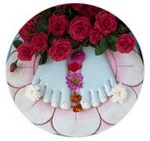Percorso

Krin Kund Baba Kina Ram Sthal

Baba Kina Ramji
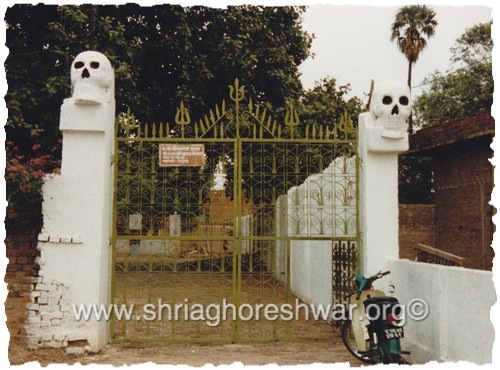
Baba Kina Ram Sthal’s entrance, 1985
Siddhapeeths are perfect and supreme places and give energy and knowledge when the Sadhaks residing there live into the profundity of their being and practice. Many Siddhapiths are places of prayer, pilgrimage and worship recognized by the pepole, others are completely unknown to the mass, because their memory has been lost or because now they are in uninhabited or not easy to reach areas. It is believed that some Aghori Masters have the power to find and reactivate the forgotten Siddhapeeths.
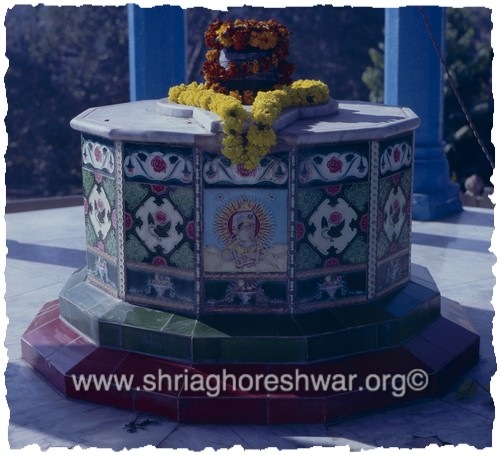
Krin Kund Baba Kina Ram Sthal Siddhapeeth is located a few hundred metres far from the crematory ground of Harischandra Ghat. This area was called Mandarvana in the Puranas and regarded as Shiva and Parvati’s favourite garden in Kashi. Here Rishi Sumedha practiced penance. It is told that during the Vedic period the owner of the area where Krin Kund was, was the Dom (the one in charge of the crematory ground and the executioner) who had bought the king of Kosala, Harischandra, as a slave, and probably it is the place where the son of the same king, while picking up some flowers, was bitten by a cobra and died. The name Krin could refer to the name of an insect present where there are many snakes.

Approximately 50 acres of forest surrounded the Kund consecrated to Shakti in the time of Baba Kalu Ram ji. A Shiva temple, Baba and Sadhus’ lodging were not far from the pond. The area was isolated, elevated and protected from river floods, an ideal place for contemplative life. Around and near the area there were only temples, ashrams or camps of sadhus immersed in lush vegetation.

Shri Aghoreshwar’s Gaddi, Krin Kund
The Doms, aware of the sacredness of the place, gave it to Baba Kina Ramji to express, in a divine and holy place, the spiritual vision received from Baba Kalu Ramji. Aghoris were the only ones who could accept donations from lower caste people and turned Krin Kund into the Perfect place, willed by God to bring back on the earth the Knowledge lost in bygone times. The place became known as Krin Kund Baba Kina Ram Sthal.
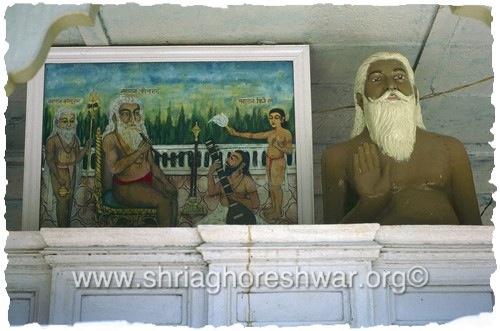
Baba Kina Ram’s Gaddhi
In this place there is the Samadhi which contains Baba Kalu Ramji’s wood sandals and shawl, the tombs of Baba Kina Ramji, of the Masters who came after him (Pithadhishwars) and other Aghoris, sixty Samadhis in all. Aghoris are not cremated but buried in Samadhis and devotees worship these tombs believing that these Masters, in their spiritual essence, are still present and able to inspire, help and bless those going there to pray.
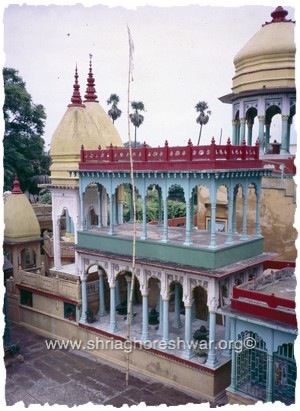
Aghoris’ Samadhi, Krin Kund
Relics such as the seat and the bed used by Baba Kina Ram, Baba Bija Ram’s sitar and objects belonged to later Masters are still kept in the Sthal. On the side of the arcade overlooking Krin Kund there is Akhand Dhuni, the fire burning continuously since the times of Baba Kina Ramji, fed with the wood taken from the shmashan, used for cooking, too.

Akhand Dhuni, Baba Kina Ram Sthal
From a room next to the Dhuni, a trap door leads to an underground room, used for meditation. A huge tamarind tree in the backside garden gave shelter to a colony of flying foxes (giant bats) which were there since when Baba Bija Ramji, while playing sitar for Baba Kina Ramji, was carried away to the sky. When he came down again his body was covered with these bats, to which Baba Kina Ramji ordered to alight on the tree and since then the colony of these flying mammals stayed at the Sthal till a short time after Shri Aghoreshwar’s Samadhi.

Giant bats on the tamarind tree, Krin Kund
Krin Kund water has curative powers: women and kids can recover from some pathologies if they bathe in it on particular days of the week. Besides a well dug by Baba Kina Ramji, near the present entrance, provides water suitable for treating abdominal and digestive disorders. Aghoris consider Krin Kund as the abode of Hinglaj Devi and the sum of all the places of pilgrimage and the whole Sthal as an extension of Girnar.

Instructions for curative baths inside Krin Kund
In the course of time, from Baba Kina Ramji onwards, many Masters flew from the Sthal after having been initiated there and brought the knowledge of Kinaramis throughout the continent. Some of them gave birth to lineages still active in other states of India.

Aghoris have always helped and protected the most marginalized classes of society and Babas of Krin Kund, from Kina Ram onwards, interceded many times for poor, helpless and exploited people.

In 1978, after Baba Rajeshwar Ramji’s Samadhi, Shri Aghoreshwar effected a wise preservative restoration which allowed to keep the architectural features of the place. Today, unfortunately, what had been sensitively protected and handed on will be completely replaced with a modern building which doesn’t convey the pathos that the previous complex emanated.

The Masters (Pithadhishwars) of Sthal line of succession are the following ones:
1) Baba Kalu Ramji
2) Baba Kina Ramji
3) Baba Bija Ramji
4) Baba Dhantar Ramji
5) Baba Gaibi Ramji
6) Baba Bhawani Ramji
7) Baba Jayanarayan Ramji
8) Baba Mathura Ramji
9) Baba Saryu Ramji
10) Baba Dal Singar Ramji
11) Baba Rajeshwar Ramji
12) Baba Siddharth Gautam Ramji
